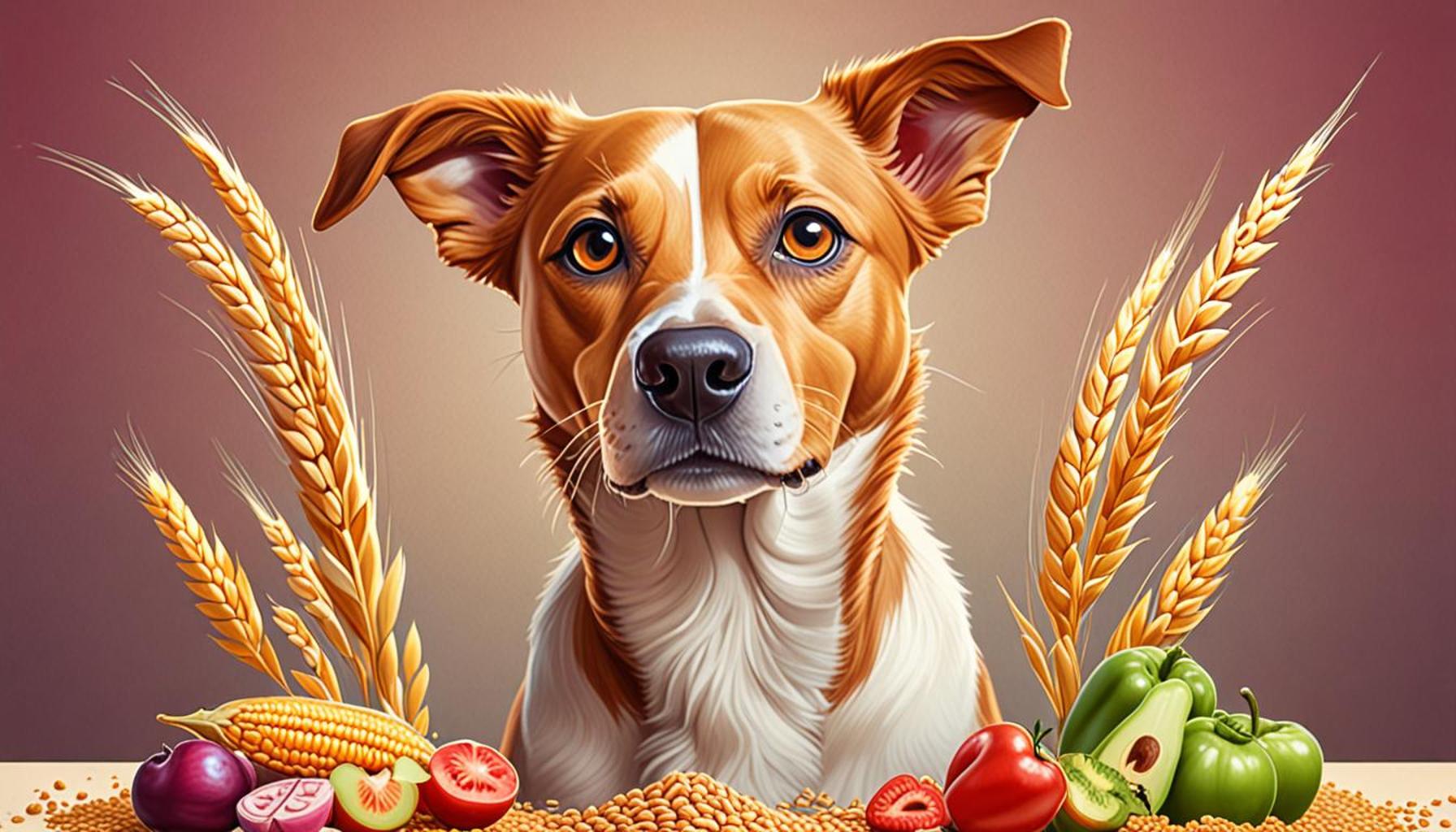The Impact of Grain-Free Diets on Dog Health

Understanding the Shift in Canine Nutrition
The rise of grain-free diets for dogs has sparked much conversation among pet owners and veterinarians alike. As many pet parents seek better options for their furry friends, the question arises: what are the true effects of such diets on canine health? With an increase in awareness around pet nutrition, understanding these diets requires a deep dive into both their origins and their implications for our canine companions.
Grain-free diets often appeal to dog owners for several reasons, primarily centered around the well-being of their pets. One significant factor is the growing belief in potential allergies. Many pet owners suspect that common grains like wheat, corn, and soy could be responsible for skin irritations or digestive issues, leading them to explore alternatives that omit these ingredients. This trend aligns with observations in both dogs and humans, where some individuals showcase sensitivities to gluten and other grain proteins.
- Potential allergies: The notion that grains may trigger allergies in dogs has influenced many owners to consider grain-free options, even though concrete evidence remains limited.
- High protein content: These diets often emphasize a higher protein intake, predominantly sourced from meat, which can be attractive to owners looking to mirror the ancestral diets of dogs.
- Weight management: Grain-free formulations can sometimes be lower in carbohydrates, which appeals to those concerned about their pet’s weight, especially in an era where canine obesity is increasingly prevalent in the U.S.
However, the impact of these diets remains a topic of ongoing research. While some studies suggest potential health benefits linked to grain-free diets, such as:
- Improved coat condition: Many owners report that their pets display shinier and healthier coats, which can attribute to higher levels of essential fatty acids found in meat-based diets.
- Enhanced digestion: A grain-free diet may lead to better gut health for certain dogs, particularly those sensitive to grains, resulting in firmer stools and less incidence of gastrointestinal distress.
- Increased energy levels: Reports have emerged from dog owners who observe their pets becoming more energetic and playful after switching to a grain-free diet.
Despite these positive aspects, it is crucial to address concerns surrounding cardiac issues and nutritional deficiencies reported in some dogs on grain-free diets. The U.S. Food and Drug Administration (FDA) has investigated links between grain-free diets and cases of dilated cardiomyopathy (DCM), a serious heart condition primarily seen in certain breeds. Such findings have prompted many veterinarians to advise caution when considering these diets, emphasizing the need for proper research and professional guidance.
Ultimately, the debate surrounding grain-free vs. standard diets is complex, with valid points on both sides. This discourse invites dog owners to explore dietary options while consulting with trusted veterinarians to ensure that their beloved pets receive balanced nutrition tailored to their individual needs.

DIVE DEEPER: Click here to learn more about pet nutrition
The Nutritional Breakdown: What’s in Grain-Free Diets?
To fully understand the impact of grain-free diets on dog health, it’s essential to examine what these diets typically consist of. Generally, grain-free formulations prioritize animal-based proteins and replace traditional grains with alternative carbohydrate sources. The most prevalent substitutes include ingredients like potatoes, peas, and lentils. These alternatives cater to the belief that dogs, as descendants of wolves, thrive on a high-protein diet more akin to their ancestors’ consumption.
In addition to the primary ingredients, grain-free dog foods tend to contain various vitamins, minerals, and health-promoting additives designed to support overall canine well-being. However, while the profiles of these diets can appear balanced, not all canine nutritional needs are equally met depending on the specific formulation.
- Protein content: Grain-free diets often boast higher protein levels. Sources such as chicken, beef, and fish are prevalent, emphasizing the potential for muscle development and maintenance.
- Carbohydrate alternatives: Ingredients like sweet potatoes and pumpkin provide energy while being easier to digest compared to traditional grains for some dogs.
- Filling ingredients: Many grain-free formulations include fillers like flaxseed or coconut meal, which can offer additional fiber and nutritional value.
While many dog owners report positive outcomes after transitioning to grain-free diets, including improvements in coat quality and overall vitality, the potential downsides require attention. A significant concern raised is the occurrence of nutritional deficiencies. Dogs require a balanced diet that includes a range of nutrients, especially essential amino acids, vitamins, and minerals. While traditional dog foods with grains often provide a comprehensive nutrient profile, some grain-free options might lack adequate supplementation, particularly if they do not contain varied protein sources.
Moreover, the focus on specific protein sources may inadvertently lead to allergies or intolerances, as dogs may be exposed to higher concentrations of a single protein type over time. This factor can result in adverse reactions that could mirror the symptoms often attributed to grain intake.
Monitoring Health After Switching Diets
For dog owners considering a change to grain-free diets, monitoring their pet’s health closely during the transition period is crucial. Signs that a grain-free diet may not be suitable can include:
- Stomach upset: Symptoms such as diarrhea, vomiting, or excessive gas can indicate an intolerance to the new diet.
- Skin irritations: If your dog develops rashes or itching post-switch, it could signify an allergic reaction to one of the protein sources.
- Weight changes: An increase or decrease in your pet’s weight may indicate the diet is not meeting their energy needs.
Dogs are unique, and their nutritional needs can vary widely based on breed, age, weight, and health conditions. Thus, consulting with a veterinarian before implementing any major dietary changes is advisable. This guidance is vital to ensure that your furry friend receives a balanced diet tailored to their individual health profile.
| Advantages | Description |
|---|---|
| Improved Skin Health | Many dog owners report a decrease in skin allergies and irritations when switching to grain-free diets. |
| Better Digestive Health | A grain-free diet may enhance nutrient absorption, leading to better overall digestive health and less gastrointestinal distress. |
| Increased Energy Levels | Some dogs exhibit heightened vitality and improved stamina when eating grain-free meals, contributing to healthier weight management. |
| Weight Management | Grain-free diets often consist of higher protein content, helping dogs to maintain a healthy weight and muscle mass. |
The rising trend of grain-free diets for dogs has sparked widespread discussion regarding their effectiveness and potential health benefits. Pet owners are increasingly intrigued by the possibility of addressing common health issues through dietary adjustments. Proponents of grain-free nutrition suggest that eliminating grains can lead to a range of health improvements, marking a significant shift from traditional pet food formulations. However, while many anecdotal reports claim positive changes, scientific research remains necessary to substantiate these benefits fully. Transitioning to a grain-free diet, especially for dogs with pre-existing health conditions, should be approached with professional guidance. Monitoring the dog’s reaction to the dietary changes is crucial, ensuring that the chosen food meets their individual health needs. As more studies are conducted to examine the long-term effects of grain-free diets on dog health, the conversation will certainly evolve, encouraging dog owners to make informed choices tailored to their pet’s optimal wellbeing.
DISCOVER MORE: Click here to learn about game-based training methods
Potential Health Risks: A Closer Look at Grain-Free Diets
While many pet owners are drawn to grain-free diets due to perceived benefits, it is essential to acknowledge the potential health risks that accompany this dietary shift. As public interest in alternative nutrition for dogs grows, unexpected consequences have emerged that warrant close scrutiny.
One significant concern has been the reported association between grain-free diets and canine dilated cardiomyopathy (DCM), a serious heart condition that affects the heart’s ability to pump blood effectively. Research from the FDA published in 2018 highlighted a trend in cases of DCM linked to certain grain-free dog foods, particularly those high in peas, lentils, and other legume-based ingredients. While the extent of this relationship is still under investigation, dog owners must be vigilant and consider the long-term implications.
Another often-overlooked aspect is the potential for nutritional imbalances. Protein-rich diets, while essential for canine health, may inadvertently result in excesses of certain nutrients, such as fat, especially if not carefully balanced. Dogs on grain-free diets could be getting too much of certain protein and not enough fiber, which can affect gut health and overall digestion. A lack of fiber can lead to issues such as constipation or unhealthy gut microbiota, which is crucial for immune function and nutrient absorption.
- Micronutrient Deficiencies: Grain-free diets often lack key vitamins and minerals found in whole grains, particularly B vitamins and iron, which are pivotal for energy metabolism and red blood cell production.
- Excess Protein: High protein levels may lead to kidney strain in some dogs, especially those with pre-existing kidney conditions. Consequently, owners should monitor their dog’s kidney health when switching to a protein-intensive diet.
- Introducing New Allergens: Switching to grain-free diets introduces different proteins and ingredients that might not have been part of a dog’s prior diet and can lead to allergic reactions.
Real-Life Stories and Case Studies
The implications of grain-free diets are further emphasized by real-life experiences from dog owners. A case study in veterinary publications detailed a Golden Retriever that showed a significant decline in health after a switch to a grain-free diet focused on peas and lentils. The dog developed signs of lethargy, a bloated abdomen, and an irregular heartbeat. Upon reverting to a traditional diet with grains, the dog’s health improved dramatically, illustrating a significant correlation between the diet change and the onset of health issues.
Moreover, anecdotal reports from dog owners echo health challenges similar to those observed in veterinary settings. Many owners have noted that while their dogs appeared to thrive initially on grain-free diets, problems often surfaced months later, suggesting the need for ongoing monitoring regardless of positive early signs. Owners should remain open to reevaluating nutritional choices as their pets age, as requirements can evolve.
In a broader context, the evolving landscape of pet nutrition calls for critical analysis of dog food labels. Pet owners must become diligent in reading ingredient lists and seeking formulations that address their dog’s unique needs without compromising overall health. Collaboration with veterinarians becomes vital in navigating this complex realm to ensure dogs maintain a wholesome, balanced diet tailored to their specific health circumstances.
LEARN MORE: Click here to discover the link between playtime and your pet’s well-being
Conclusion: The Importance of Informed Choices for Canine Nutrition
As we delve further into the complexities of canine nutrition, the topic of grain-free diets remains both intriguing and controversial. While these diets have gained popularity among dog owners seeking healthier alternatives, the emerging evidence surrounding their potential health risks demands careful consideration. The correlation noted between grain-free diets and canine dilated cardiomyopathy (DCM), alongside the critical issue of nutritional imbalances, highlights the necessity for a balanced perspective on dietary choices.
Veterinary insights advocate for a cautious approach, urging dog owners to be proactive in monitoring their pets’ health, especially when introducing new diets rich in unconventional ingredients. The varying responses of dogs to such diets underline the importance of individualized nutrition. By recognizing the potential pitfalls, including micronutrient deficiencies and excess protein, pet owners can make informed decisions that suit their canine companions’ unique health needs.
Ultimately, fostering an understanding of how nutrition directly impacts our pets’ well-being could lead to better outcomes and improved longevity. As science continues to shed light on the effects of grain-free diets, pet owners are encouraged to engage in conversations with veterinarians, scrutinize ingredient labels, and observe any changes in their dogs’ health over time. By doing so, they can craft a wholesome and balanced diet tailored to ensure their furry friends lead healthy, fulfilling lives.



